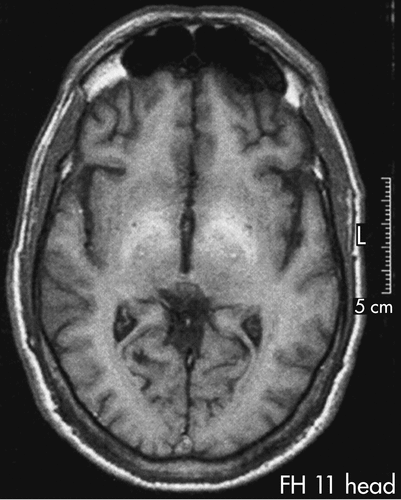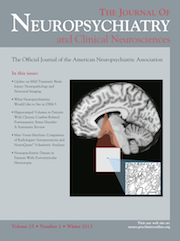Acute Confusion After Minimal Hepatic Encephalopathy
To the Editor: We present the case of a 67-year-old man with a history of portal vein thrombosis due to chronic hepatitis B, presenting at the emergency room with acute confusion. Magnetic resonance imaging of the brain revealed hyperintensities in the basal ganglia bilaterally. Neuropsychological testing and electroencephalography confirmed an encephalopathic process. The patient was treated with lactulose and returned to normal. Minimal hepatic encephalopathy (MHE) is a newly-recognized syndrome that could cause episodes of confusion, with the patient being normal between them. Porto-systemic shunting may be the cause of elevated ammonia levels that affect the brain. Management of MHE includes reduction in the production and absorption of ammonia.

Case Report
A 67-year-old normotensive man was admitted for evaluation of acute confusion. His past medical history was remarkable for chronic hepatitis B, complicated by portal vein thrombosis 2 years ago. According to his attending gastroenterologist, he was currently clinically stable, with no overt symptoms or signs of hepatic encephalopathy.
On examination, he was disorientated in space and time and looked anxious and nervous. He had brisk reflexes bilaterally, normal strength, and downgoing plantar reflexes. An urgent brain Computed Tomography (CT) scan was unremarkable. His biochemical and hematological profile was normal except for elevated γ-GT, mildly elevated bilirubin, and thrombocytopenia. T1-weighted brain magnetic resonance imaging (MRI) revealed hyperintensities in the basal ganglia bilaterally (Figure 1). An electroencephalogram (EEG) showed bifrontal slow-wave activity, with a frequency of 2.5 to 5 Hz, suggesting metabolic encephalopathy. Neuropsychological testing results were compatible with an encephalopathic process, showing visuospatial disabilities, slow processing speed, and memory impairment. The patient was treated with lactulose and returned to normal.
Minimal hepatic encephalopathy (MHE) is a newly-recognized syndrome that could cause episodes of confusion with the patient being normal between them.1 A diagnosis could be reached with neurophysiology (EEG, evoked potentials), and neuropsychological assessment, because the patients do not present clinical signs of overt hepatic encephalopathy.2 In our patient, chronic liver cirrhosis and portal vein thrombosis resulted in shunting of portal venous blood into the systemic circulation. Porto-systemic shunting may be the cause of elevated ammonia levels that affect brain astrocytes, resulting in defective neurotransmission and, eventually, confusion in such patients.3 Management of MHE includes identification and treatment of the precipitating cause as well as reduction in the production and absorption of ammonia.4
1 : Minimal hepatic encephalopathy matters in daily life. World J Gastroenterol 2008; 14:3609–3615Crossref, Medline, Google Scholar
2 : Advances in the evaluation and management of minimal hepatic encephalopathy. Curr Gastroenterol Rep 2011; 13:26–33Crossref, Medline, Google Scholar
3 : Contribution of hyperammonemia and inflammatory factors to cognitive impairment in minimal hepatic encephalopathy. Metab Brain Dis 2011; (E-pub ahead of print).Google Scholar
4 : Clinical efficacy and safety of lactulose for minimal hepatic encephalopathy: a meta-analysis. Eur J Gastroenterol Hepatol 2011; 23:1250–1257Crossref, Medline, Google Scholar



